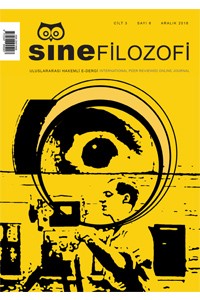Abstract
It can be claimed that the representations of femininity and masculinity in the cinema reinforce the dominant masculine discourse. Not only representations of femininity and masculinity, but also another dimension of the sovereign discourse about Eastern / Western societies in mainstream cinema. While East is depicted as powerful hegemonic, East is represented as a place that needs to be civilized. Furthermore, East is associated with femininity and the West with masculinity in the dominant discourse of the cinema. The film, M. Butterfly, reverses this hierarchical discourse formally. M. Butterfly was examined through the question of what power/identity is through taking into consideration of this reversed discourse of East/West and feminity/masculinity. The ambiguity of meaning was emphasized while questioning hegemony of West in this article. Moreover it was also aimed to analyze what forms of counter hegemony are while mentioning ambiguity of construction. The suicide of protagonist in M. Butterfly which is inspired of Madam Butterfly opera, was also taken into consideration while questioning what identity and gender are. This article is qualitative and deconstructive analysis was uses in the analysis of the film as a text. It was found that no structures were ultimately constructed in the film, and that the established structures were constantly changing.
References
- Burcu, E. (1998). Evrimci teorinin sosyolojik düşünce üzerindeki etkileri ve sosyobiyoloji. Hacettepe Üniversitesi Edebiyat Fakültesi Dergisi 15 (2), 175-186. Butler, J. (1988). Performative acts and gender constitution: an essay in phenomenology and feminist theory. Theatre Journal 40 (4), 519-531. Connell, R.,W., (2005). Masculinities.Los Angeles: University California Press. Cronenberg, D. (Yönetmen). (1993). M. Butterfly. USA: Warner Bros. Hwang, D.H. (1992). M. Butterfly. (A. Taygun,Çev.). İstanbul: Can. Esplen, E. ve Jolly, S. (2006). Gender and Sex a Sample of Definitions. U.K: Bridge. Fausto-S.A. (2000). Sexing the Body. New York: Basic Books. Foucault, M. (1992). Hapishanenin Doğuşu. (M. A. Kılıçbay, Çev.). Ankara: İmge. Foucault, M. (2002). Toplumu Savunmak Gerekir. (Ş. Varaktaş, Çev.). İstanbul: Yapıkredi. Goffman, E. (2014). Günlük Yaşamda Benliğin Sunumu. (B. Cezar, Çev.). İstanbul: Metis. Hall, S. (1997). Old and New Identities, Old and New Ethnicities . A.,D. King (Ed.), Culture, globalization and the world-system contemporary conditions for the representation of identity (40- 68). New York: University Minnesota Press. Hoffman, H. (1997). Stereotypes as reinforced structure in M. Butterfly. Undergraduate Review 10 (1), 53-60. Moran, B. (2017). Edebiyat Kuramları ve Eleştiri. İstanbul: İletişim. Mulvey, L. (1999). Visual Pleasure and Narrative Cinema. L.Braudy ve M. Cohen (Ed.), Film theory and criticism (833-844). New York: Oxford University Press. Oluk, A. (2013). Klasik Anlatı Sineması. İstanbul: Hayalperest. Puccini, G. (1903). Madam Butterfly. [Opera]. Said, W. E. (2003). Şarkiyatçılık. (B. Ülner,Çev.) Ankara: İmge. Sarup, M. (1997). Post-Yapısalcılık ve Postmodernizm. (B. Güçlü, Çev.) Ankara: Bilim ve Sanat. Sayer, A. (1997). Essentialism, social constructionism and beyond. Sociological Review 45 (3), 453-487. Uluç, G. ve Soydan, M. (2007). Said, oryantalizm, resim ve sinemanın kesişme noktasında Harem Suare. Türk Dünyası Sosyal Bilgiler Dergisi. 42, 35-53.
Abstract
Sinemada
kadınlık ve erkeklik temsillerinin egemen söylemi ataerkil yapıyı devam ettiren
bir biçimde olduğu ifade edilebilir. Yalnızca kadınlık ve erkeklik biçimleri
değil, sinemadaki egemen söylemin bir diğer boyutu da Doğu/Batı toplumlarına
yöneliktir. Bu söylemde Doğu eğitilmesi gereken
bir toplum olarak tasvir edilirken, Batı güçlü
ve iktidar sahibi olarak tasvir
edilmektedir. Yine sinemanın egemen söyleminde karşımıza Doğu’nun kadınlık ve
Batı’nın erkeklik hali ile ilişkilendirilmesi çıkmaktadır. M. Butterfly filmi ise bu hiyerarşik söylemi biçimsel olarak yıkıma
uğratmaktadır. Bu araştırmada M.
Butterfly filmi kadın/erkek, Doğulu/Batılı olma biçimlerini ters yüz etmesi
iktidar/kimlik nedir sorusu üzerinden incelenmektedir. Bu araştırma anlamın
ikircikliğinden yola çıkılarak, bir taraftan Batı’nın Doğu üzerindeki
hegemonyasını sorgulamayı amaçlarken, diğer yandan karşı-hegemonya biçimlerini
tartışmaktadır. Bunun yanı sıra M.
Butterfly eserinin konu olarak dayandığı Madam Butterfly opera eserindeki kahraman ile incelenen eserdeki
kahramanın intihar etmesi üzerinden kimlik ve cinsiyet rollerinin
süreklilikleri, ikilemleri ve çıkmazları ortaya konulmuştur. Araştırmada yöntem olarak yapı-bozuma
başvurulmuştur.
References
- Burcu, E. (1998). Evrimci teorinin sosyolojik düşünce üzerindeki etkileri ve sosyobiyoloji. Hacettepe Üniversitesi Edebiyat Fakültesi Dergisi 15 (2), 175-186. Butler, J. (1988). Performative acts and gender constitution: an essay in phenomenology and feminist theory. Theatre Journal 40 (4), 519-531. Connell, R.,W., (2005). Masculinities.Los Angeles: University California Press. Cronenberg, D. (Yönetmen). (1993). M. Butterfly. USA: Warner Bros. Hwang, D.H. (1992). M. Butterfly. (A. Taygun,Çev.). İstanbul: Can. Esplen, E. ve Jolly, S. (2006). Gender and Sex a Sample of Definitions. U.K: Bridge. Fausto-S.A. (2000). Sexing the Body. New York: Basic Books. Foucault, M. (1992). Hapishanenin Doğuşu. (M. A. Kılıçbay, Çev.). Ankara: İmge. Foucault, M. (2002). Toplumu Savunmak Gerekir. (Ş. Varaktaş, Çev.). İstanbul: Yapıkredi. Goffman, E. (2014). Günlük Yaşamda Benliğin Sunumu. (B. Cezar, Çev.). İstanbul: Metis. Hall, S. (1997). Old and New Identities, Old and New Ethnicities . A.,D. King (Ed.), Culture, globalization and the world-system contemporary conditions for the representation of identity (40- 68). New York: University Minnesota Press. Hoffman, H. (1997). Stereotypes as reinforced structure in M. Butterfly. Undergraduate Review 10 (1), 53-60. Moran, B. (2017). Edebiyat Kuramları ve Eleştiri. İstanbul: İletişim. Mulvey, L. (1999). Visual Pleasure and Narrative Cinema. L.Braudy ve M. Cohen (Ed.), Film theory and criticism (833-844). New York: Oxford University Press. Oluk, A. (2013). Klasik Anlatı Sineması. İstanbul: Hayalperest. Puccini, G. (1903). Madam Butterfly. [Opera]. Said, W. E. (2003). Şarkiyatçılık. (B. Ülner,Çev.) Ankara: İmge. Sarup, M. (1997). Post-Yapısalcılık ve Postmodernizm. (B. Güçlü, Çev.) Ankara: Bilim ve Sanat. Sayer, A. (1997). Essentialism, social constructionism and beyond. Sociological Review 45 (3), 453-487. Uluç, G. ve Soydan, M. (2007). Said, oryantalizm, resim ve sinemanın kesişme noktasında Harem Suare. Türk Dünyası Sosyal Bilgiler Dergisi. 42, 35-53.
Details
| Subjects | Communication and Media Studies, Philosophy |
|---|---|
| Journal Section | Articles |
| Authors | |
| Publication Date | December 25, 2018 |
| Published in Issue | Year 2018 Volume: 3 Issue: 6 |

